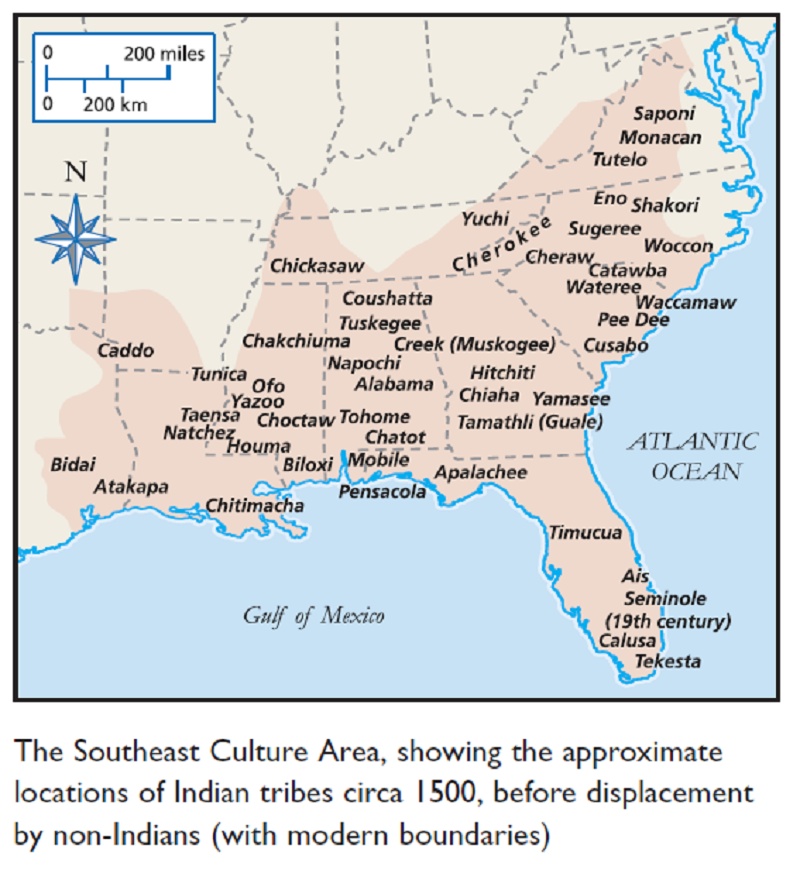
Scholars define the Southeast Culture Area as a region that borders the Atlantic Ocean to the east, the Gulf of Mexico to the south, the Trinity, Arkansas, and Mississippi Rivers (approximately) to the west, and the Tennessee and Potomac Rivers (approximately) to the north. This area comprises all of present-day Florida, Georgia, Alabama, Louisiana, and South Carolina, most of Mississippi, Tennessee, North Carolina, and Virginia, and parts of Texas, Oklahoma, Arkansas, Illinois, Kentucky, West Virginia, and Maryland.
The Southeast Culture Area is primarily forested, with yellow pine being the dominant tree species. As a result, the culture area is sometimes referred to as the Southeast Woodland Culture Area. However, there is a significant variation in terrain and vegetation in the Southeast, including coastal plains with saltwater marshes, grasses, and stands of cypress trees, subtropical Everglades with jungle and swampland, sandy soil of river valleys, plus the Mississippi floodplain, fertile soil of the Black Belt, and forested highlands of the Piedmont Plateau, Blue Ridge, Smoky Mountains, and Cumberland Mountains, all part of the southern Appalachian chain.
The indigenous peoples of the Southeast were skilled hunters and fishermen who gathered wild plant foods. But they were also highly skilled farmers, growing corn, beans, squash, melon, sweet potatoes, and other crops. Because they could grow enough food to support a sizable population, Southeast Indians primarily lived in permanent villages, usually located in river valleys. The main type of architecture used was wattle and daub, where branches and vines were tied over pole frameworks and covered with a mixture of mud plaster. Plant materials such as thatch, grass, bamboo stalks, palm fronds, bark, and woven mats, as well as animal hides, were also used to cover both rectangular and circular structures.
The Southeast was home to numerous tribes, including those of the Muskogean, Iroquoian, and Siouan language families, as well as tribes speaking language isolates. The most widespread language family in the region was the Muskogean, and tribes like the ALABAMA, APALACHEE, CHICKASAW, CHOCTAW, COUSHATTA, CREEK, MOBILE, SEMINOLE, and YAMASEE, have entries in this book. The CALUSA, also represented, probably spoke the Muskogean language too.
The CHEROKEE were the only Southeast tribe of the Iroquoian language family with an entry, and the CATAWBA and SHAKORI were the only Southeast tribes of the Siouan language family with entries. The CADDO, representing the Caddoan language family, were the only tribe of that language family with an entry.
The LUMBEE, represented in this book, were thought to be primarily descended from people speaking mostly Siouan but may have had ALGONQUIANS and IROQUOIANS among their ancestors as well. The ATAKAPA, CHITIMACHA, NATCHEZ, TIMUCUA, and YUCHI were Southeast tribes with unique languages or language isolates, each with separate entries. The Tunican language of the Macro-Algonquian phylum, spoken by the TUNICA and YAZOO, is discussed as a language isolate by some linguists and as a family by others.
There are many other tribes of the Southeast Culture
Area, which, because of limited space, do not have separate
entries. Most of them now are extinct.
Muskogeans without entries include Acolapissa, Ais, Apalachicola, Avoyel, Bayogoula, Chakchiuma, Chatot, Chiaha, Cusabo, Guale, Hitchiti, Houma, Kaskinampo, Muklasa, Napochi, Oconee, Okelousa, Okmulgee, Pawokti, Pensacola, Quinipissa, Sawokli, Tamathli, Tangipahoa, Taposa, Tawasa, Tohome, and Tuskegee. (The following tribes also are thought to be Muskogean: Amacano, Caparaz, Chine, Choula, Guacata, Ibitoupa, Jeaga, Osochi, Pascagoula, and Tekesta.)
Siouans without entries include Biloxi, Cheraw, Manahoac,
Monacan, Moneton, Nahyssan, Occaneechi, Ofo,
Pee Dee, Santee (Issati), Saponi, Sewee, Sissipahaw, Sugeree,
Tutelo, Waccamaw, Wateree, Waxhaw, Winyaw,
and Woccon. The Cape Fear, Congaree, Eno, Keyauwee,
and Yadkin tribes of the region also are assumed to be
Siouan.
Caddoans without entries include Adai and Eyeish. Southeast tribes speaking language isolates without entries include Akokissa (related to Atakapa), Bidai, Deadose, and Patiri, speaking Atakapan; Griga, Koroa, and Tiou, speaking Tunican; and Taensa, speaking Natchesan.